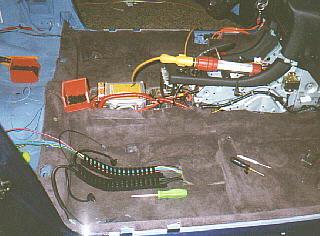 1 1 |
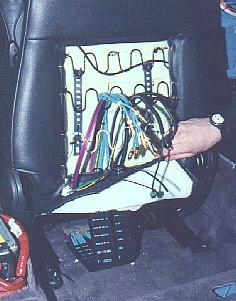 2 2 |
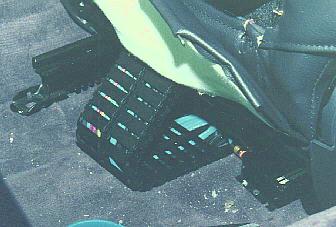 3 3 |
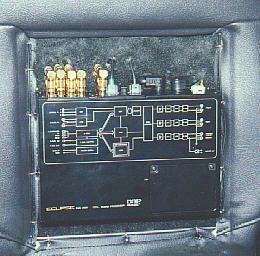 4 4 |
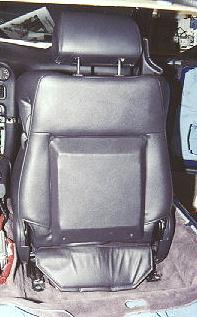 5 5 |
When I designed the processor into the back of the passenger seat, I wasn't really sure if it was a feasible task. But I really wanted it there because it was out of the way, completely, and I rarely (if ever) have to worry about fitting people into the back seat (yeah, right) so leg room was obviously not under consideration. I just wasn't sure how I was going to run all those cables up into the seat. I had figured on running it up the side and wire-tie/looming them. Well, that problem was solved when I was talking about the design with Bruce and he showed me a new linkable conduit he had come across. I took one look at that and knew my problem was solved.
The track can be any length you want, just by adding another link to it. It was ideal because it was very sturdy but very easy to flex along it's bend path (follow that? ;-) and it would only curve so far. I.e., it wouldn't kink on itself or the wires it housed. This was perfect since I had to run 2 glass fiber optic cables up into the seat. The track's properties would keep people's feet from getting tangled in the cables and damaging them and keep the fiber optics from bending too far and breaking.
The first picture shows the initial running of wires through the track. The carpet was cut to keep the cables underneath until just before they went into the track. Picture 2 shows the cables after they have all been run through the track and the passnger seat put back in the car. A little of the foam was removed to give the cables channel/paths to rest in, so they would not be pressed against the springs of the seat. What are all the cables for? Two DIN cables to control the head unit and changer; two fiber optic cables for CD signal from head unit and changer; 4 sets of RCA cables for the front, rear, center, and sub amps; and power wires for the unit itself.
Picture 3 shows the track once everything is installed and in place. Mounted right beside the base of the track is a Rockford Fosgate Balanced Line Transmitter that sends the signal to the Punch 250m2 amplifier for the front stage. The track works perfectly for what it is supposed to do and was definitely the concept I had in mind but didn't know existed when I designed the system. Funny, too - I've never seen it used in any other installation I've seen.
The fourth picture shows the processor once it's mounted and in place. As you can see back up in picture 2, it wasn't easy to mount it since it's essentially mounted to the springs in the back of the passenger seat. There are 2 metal brackets mounted to the springs in the seat and a piece of 1/4" masonite is mounted to that. The processor is then bolted to the masonite. It fit perfectly between the metal bars holding the vinyl of the seat. it was finished off with Stinger charcoal grey carpet. Gold plated RCA angle-adapters were used to connect the cables to the unit.
The bottom picture shows the passenger seat with the custom-built cover in place. It was initially built with a hard blue foam material attached to a 1/4" piece of masonite, with the factory piece of vinyl stretched around it. This piece didn't last long, the foam broke. So it was rebuilt with MDF and the vinyl was again stretched around this piece and it's been perfect ever since. The original clips are used to attach the cover at the top and then 2 screws attach the bottom to the support structure of the seat. The flap at the bottom of the seat was there originally and conceals the conduit track and BLT.
And to top it all off, someone sitting in the passenger seat would never have a clue what they're really sitting on without me telling them. It made no change in the way the seat sits or its comfort.

